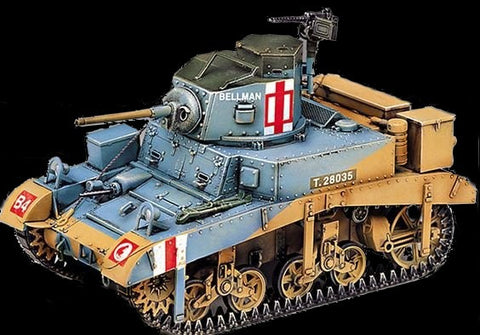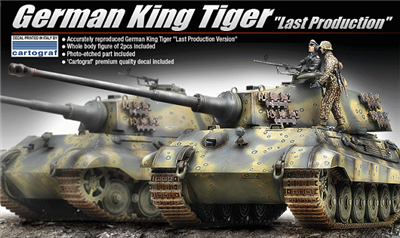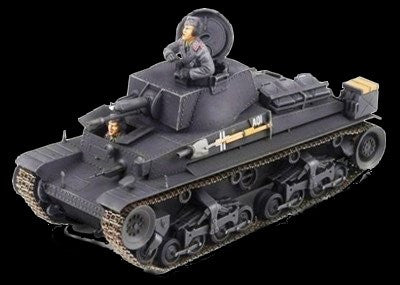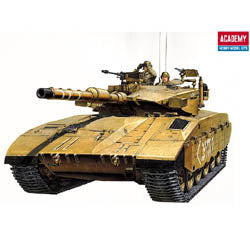
Unimodel Military 1/72 Captured T34(r) Flakpanzer Kit
This Product Usually Ships In 2-3 Business Days
UNM-254DISCONTINUED ITEM - WHILE SUPPLIES LAST
The T-34 was a Soviet medium tank which had a profound and permanent effect on the fields of tank tactics and design. First deployed in 1940, it has often been described as the most effective, efficient, and influential design of World War II. At its introduction, the T-34 possessed the best balance of firepower, mobility, protection, and ruggedness of any tank (though its initial battlefield effectiveness suffered due to a variety of factors). Its 76.2 mm (3 in) high-velocity gun was the best tank gun in the world at that time; its heavy sloped armor was impenetrable by standard anti-tank weapons; and it was very agile. Though its armor and armament were surpassed later in the war, when they first encountered it in battle in 1941 German tank generals von Kleist and Guderian called it "the deadliest tank in the world.
The T-34 was the mainstay of Soviet armored forces throughout World War II. The design and construction of the tank were continuously refined during the war to enhance effectiveness and decrease costs, allowing steadily greater numbers of T-34s to be fielded despite heavy losses. It was the most-produced tank of the war, and the second most-produced tank of all time, after its successor, the T-54/55 series. By the end of the war in 1945 the T-34 had replaced many light and heavy tanks in Red Army service. It accounted for the majority of Soviet tank production, and following the war it was widely exported. Its evolutionary development led directly to the T-54/55 series of tanks, built until 1981 and still operational as of 2013 and which itself led to the T-62, T-72, and T-90 tanks which, along with several Chinese tanks based on the T-55, form the backbone of many armies even today. In 1996, T-34 variants were still in service in at least 27 countries. After the battles with the Japanese Army, Koshkin convinced Soviet leader Joseph Stalin to let him develop a second prototype, a more heavily armed and armored "universal tank" which reflected the lessons learned in those battles, and could replace both the T-26 and the BT tanks. Koshkin named the second prototype A-32, after its 32 mm (1.3 in) of frontal armor. It had a L-10 76.2 mm (3 in) gun, and the same Model V-2-34 diesel Both were tested in field trials at Kubinka in 1939, with the heavier A-32 proving to be as mobile as the A-20. A still heavier version of the A-32, with 45 mm (1.77 in) of front armour, wider tracks, and a newer L-11 76.2 mm gun, was approved for production as the T-34. Koshkin chose the name after the year 1934, when he began to formulate his ideas about the new tank, and to commemorate that year's decree expanding the armored force and appointing Sergo Ordzhonikidze to head tank production.
Valuable lessons from Lake Khasan and Khalkhin Gol regarding armor protection, mobility, quality welding, and main guns were incorporated into the new T-34 tank, which represented a substantial improvement over the BT and T-26 tanks in all four areas. Koshkin's team completed two prototype T-34s in January 1940. In April and May, they underwent a grueling 2,000-kilometre (1,200 mi) drive from Kharkiv to Moscow for a demonstration for the Kremlin leaders, to the Mannerheim Line in Finland, and back to Kharkiv via Minsk and Kiev. Some drivetrain shortcomings were identified and corrected.While these factories were being rapidly relocated, the industrial complex surrounding the Dzherzhinski Tractor Factory in Stalingrad continued to work double shifts throughout the period of withdrawal (September 1941 to September 1942) to make up for production lost, and produced 40% of all T-34s during the period. As the factory became surrounded by heavy fighting in the Battle of Stalingrad in 1942, the situation there grew desperate: manufacturing innovations were necessitated by material shortages, and stories persist of unpainted T-34 tanks driven out of the factory directly to the battlefields around it. Stalingrad kept up production until September 1942.
The T-34 was the mainstay of Soviet armored forces throughout World War II. The design and construction of the tank were continuously refined during the war to enhance effectiveness and decrease costs, allowing steadily greater numbers of T-34s to be fielded despite heavy losses. It was the most-produced tank of the war, and the second most-produced tank of all time, after its successor, the T-54/55 series. By the end of the war in 1945 the T-34 had replaced many light and heavy tanks in Red Army service. It accounted for the majority of Soviet tank production, and following the war it was widely exported. Its evolutionary development led directly to the T-54/55 series of tanks, built until 1981 and still operational as of 2013 and which itself led to the T-62, T-72, and T-90 tanks which, along with several Chinese tanks based on the T-55, form the backbone of many armies even today. In 1996, T-34 variants were still in service in at least 27 countries. After the battles with the Japanese Army, Koshkin convinced Soviet leader Joseph Stalin to let him develop a second prototype, a more heavily armed and armored "universal tank" which reflected the lessons learned in those battles, and could replace both the T-26 and the BT tanks. Koshkin named the second prototype A-32, after its 32 mm (1.3 in) of frontal armor. It had a L-10 76.2 mm (3 in) gun, and the same Model V-2-34 diesel Both were tested in field trials at Kubinka in 1939, with the heavier A-32 proving to be as mobile as the A-20. A still heavier version of the A-32, with 45 mm (1.77 in) of front armour, wider tracks, and a newer L-11 76.2 mm gun, was approved for production as the T-34. Koshkin chose the name after the year 1934, when he began to formulate his ideas about the new tank, and to commemorate that year's decree expanding the armored force and appointing Sergo Ordzhonikidze to head tank production.
Valuable lessons from Lake Khasan and Khalkhin Gol regarding armor protection, mobility, quality welding, and main guns were incorporated into the new T-34 tank, which represented a substantial improvement over the BT and T-26 tanks in all four areas. Koshkin's team completed two prototype T-34s in January 1940. In April and May, they underwent a grueling 2,000-kilometre (1,200 mi) drive from Kharkiv to Moscow for a demonstration for the Kremlin leaders, to the Mannerheim Line in Finland, and back to Kharkiv via Minsk and Kiev. Some drivetrain shortcomings were identified and corrected.While these factories were being rapidly relocated, the industrial complex surrounding the Dzherzhinski Tractor Factory in Stalingrad continued to work double shifts throughout the period of withdrawal (September 1941 to September 1942) to make up for production lost, and produced 40% of all T-34s during the period. As the factory became surrounded by heavy fighting in the Battle of Stalingrad in 1942, the situation there grew desperate: manufacturing innovations were necessitated by material shortages, and stories persist of unpainted T-34 tanks driven out of the factory directly to the battlefields around it. Stalingrad kept up production until September 1942.





